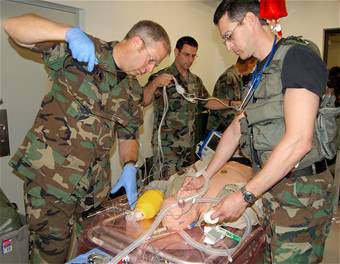 Air Force Special Operations Command has a new course to better familiarize pararescue and paramedic airmen with the world of casualty evacuation, and it includes the use of two “human-simulator” mannequins with computerized sensors that react to treatment. The first two-week course began May 15 at Hurlburt Field, Fla., with five Air Force Reserve Command individual duty medical technicians from the 920th Rescue Wing, Patrick AFB, Fla. According to MSgt. Daniel Arnold, superintendent of AFSOC medevac operations, the mannequins “breathe, bleed, blink, urinate, tear, drool, and secrete fluid from their ears.” If the trainees provide the right treatment, such as giving them epinephrine during cardiac arrest, the mannequins improve; if not, they don’t.
Air Force Special Operations Command has a new course to better familiarize pararescue and paramedic airmen with the world of casualty evacuation, and it includes the use of two “human-simulator” mannequins with computerized sensors that react to treatment. The first two-week course began May 15 at Hurlburt Field, Fla., with five Air Force Reserve Command individual duty medical technicians from the 920th Rescue Wing, Patrick AFB, Fla. According to MSgt. Daniel Arnold, superintendent of AFSOC medevac operations, the mannequins “breathe, bleed, blink, urinate, tear, drool, and secrete fluid from their ears.” If the trainees provide the right treatment, such as giving them epinephrine during cardiac arrest, the mannequins improve; if not, they don’t.
Air Force Gen. Alexus G. Grynkewich assumed command of U.S. European Command on July 1, taking over the key assignment as the U.S. and its allies contend with a resurgent Russia and a grinding war in Ukraine.
